Expert Advice on Ecommerce Conversion Rate Optimization
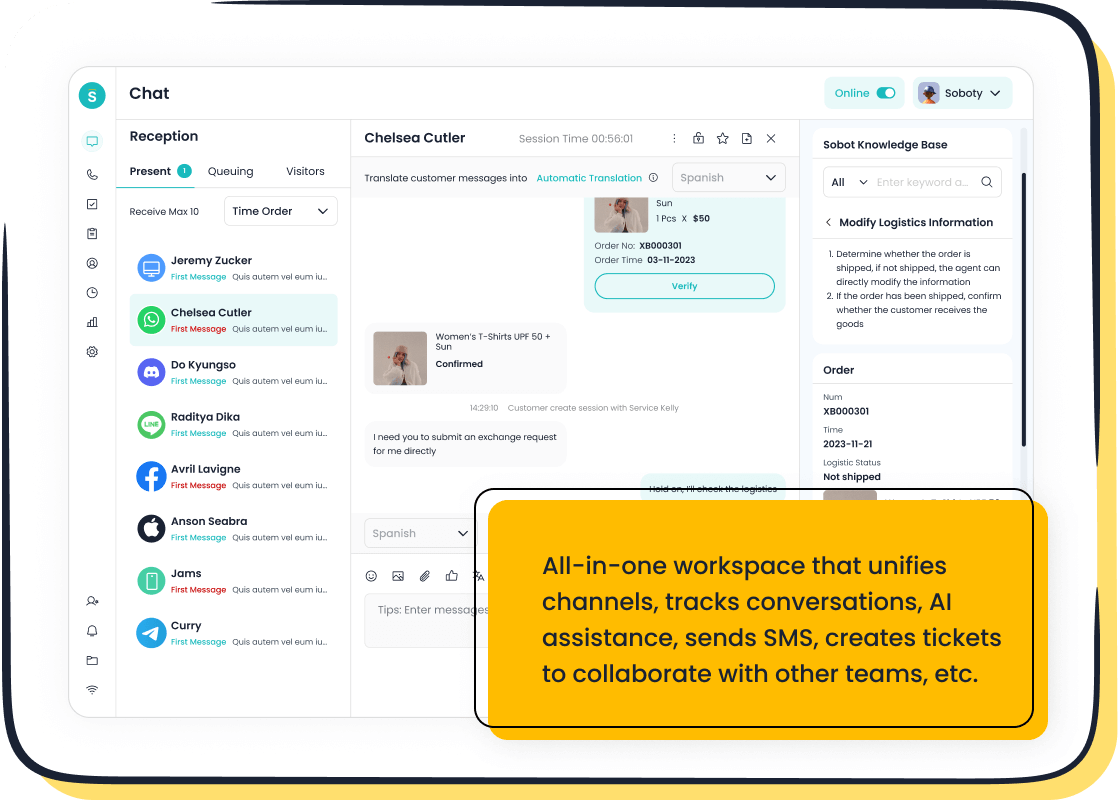
Ecommerce conversion rate optimization is all about turning more of your website visitors into paying customers. It’s not just about numbers; it’s about creating a seamless shopping experience that makes people want to click "Buy Now." Why does this matter? Imagine your site gets 1,000 visitors a day. With an average conversion rate of 3%, that’s 30 sales. But by improving that rate to 5%, you could jump to 50 sales—without spending a dime on extra traffic.
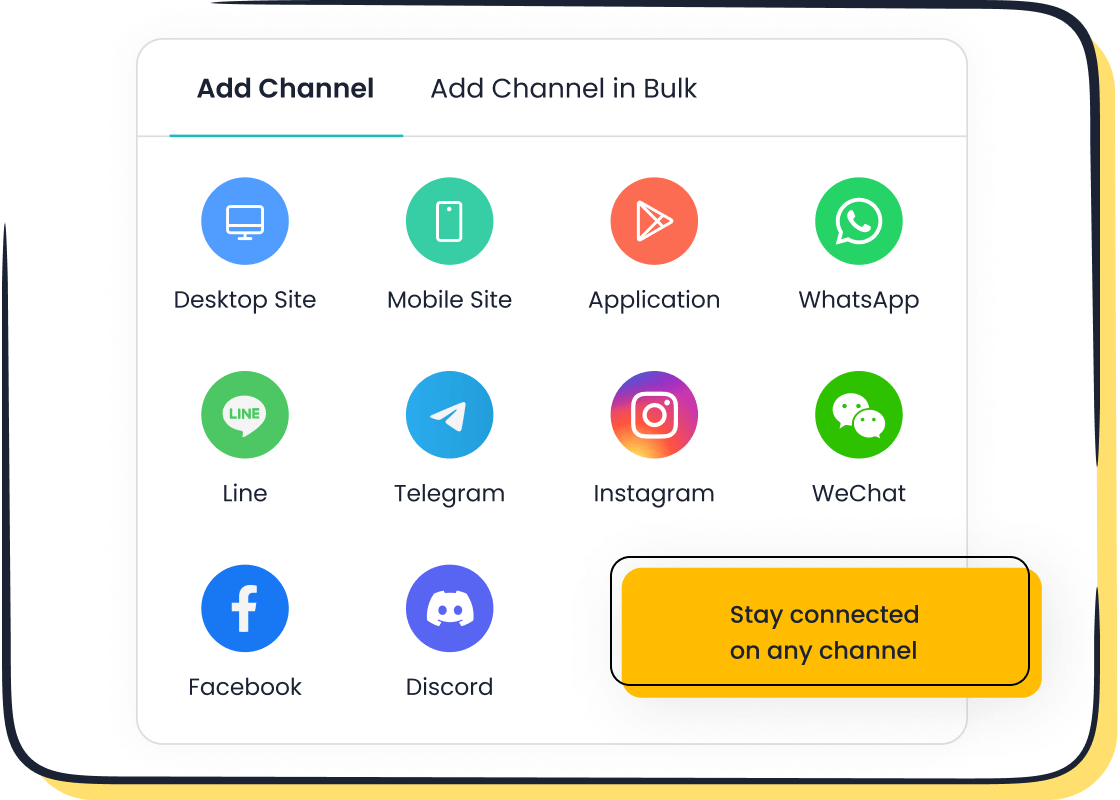
Optimizing your conversion rate also saves money. A good strategy can cut customer acquisition costs by two-thirds. Plus, satisfied customers are more likely to return, boosting loyalty. If you’re wondering how to improve ecommerce conversion rate, tools like Sobot’s Live Chat can help by engaging visitors in real time, making them feel valued and understood.
What is Ecommerce Conversion Rate Optimization?
Definition and Importance
Ecommerce conversion rate optimization (CRO) is the process of improving your website to encourage more visitors to take desired actions, like making a purchase or signing up for a newsletter. It’s not just about increasing sales; it’s about creating a better experience for your customers. When your site is easy to use and meets their needs, they’re more likely to trust your brand and come back for more.
Why is this so important? Let’s look at the numbers: the average e-commerce conversion rate is between 1% and 2%. If your store hits 3.2%, you’re already in the top 20% of Shopify stores. And if you reach 4.7%, you’re in the top 10%! That’s a big deal. Plus, products with reviews are 270% more likely to be purchased than those without. These stats show how small improvements can make a huge difference in your success.
Tip: Think of CRO as a way to maximize the value of your existing traffic. Instead of spending more on ads, you’re making the most of the visitors you already have.
How to Calculate Ecommerce Conversion Rates
Calculating your e-commerce conversion rate is simpler than you might think. The formula is:
Conversion Rate = (Number of Conversions / Total Number of Visitors) × 100
For example, if 50 people buy something out of 2,000 visitors, your conversion rate is:
(50 / 2000) × 100 = 2.5%
You can also calculate specific metrics like new visitor conversion rate or returning visitor conversion rate. Here’s a quick breakdown:
| Metric | Formula |
|---|---|
| Conversion Rate | (Number of conversions / Total number of visitors) × 100 |
| New Visitor Conversion Rate | (Number of new visitors who make a purchase / Total number of new visitors) × 100 |
| Returning Visitor Conversion Rate | (Number of returning visitors who make a purchase / Total number of returning visitors) × 100 |
| Average Revenue per Buyer | Total revenue generated / Number of unique buyers |
| Average Order Value | Total revenue / Number of orders |
Tracking these numbers helps you understand where your site is performing well and where it needs improvement. For instance, if your cart abandonment rate is high, you might need to simplify your checkout process.
Industry Benchmarks for Ecommerce Conversion Rates
Knowing how your store compares to others in your industry can give you a clear idea of what’s achievable. Here are some recent benchmarks:
| Industry | Conversion Rate (Q4 2023) |
|---|---|
| Fashion and Apparel | 1.01% - 2.20% |
| Health and Wellness | 1.87% - 4.20% |
| Pet Care | 2.20% - 2.53% |
| Food and Beverage | 3.7% |
And looking ahead to 2025, here’s what the average conversion rates might look like:
| Industry | Average Conversion Rate (2025) |
|---|---|
| Retail (Fashion, Jewelry, Shoes) | 1.9% |
| Electronics & Home Appliances | 3.6% |
| Personal Care Products | 6.8% |
| Food & Beverages | 4.9% |
| Pet Care | 2.32% |
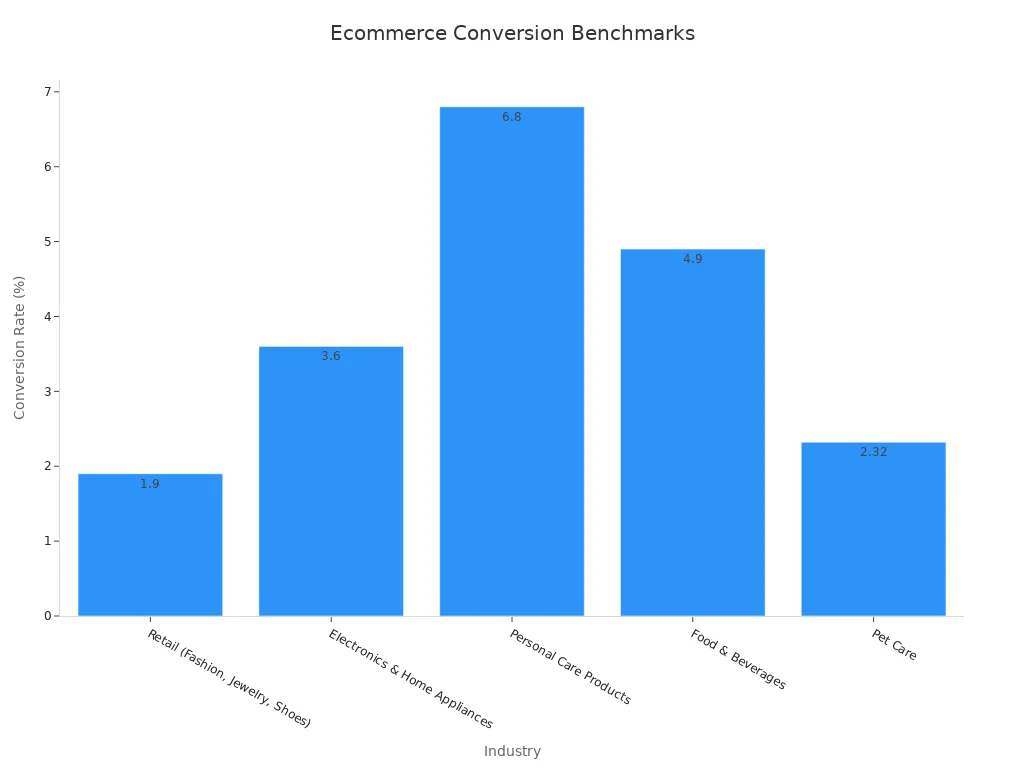
These benchmarks highlight how different industries perform. For example, personal care products tend to have higher conversion rates, while luxury and jewelry often see lower rates. Use these numbers as a guide to set realistic goals for your store.
Note: If your conversion rate is below the industry average, don’t panic. It’s an opportunity to identify areas for improvement and implement strategies like A/B testing or optimizing your product pages.
How to Improve Ecommerce Conversion Rate
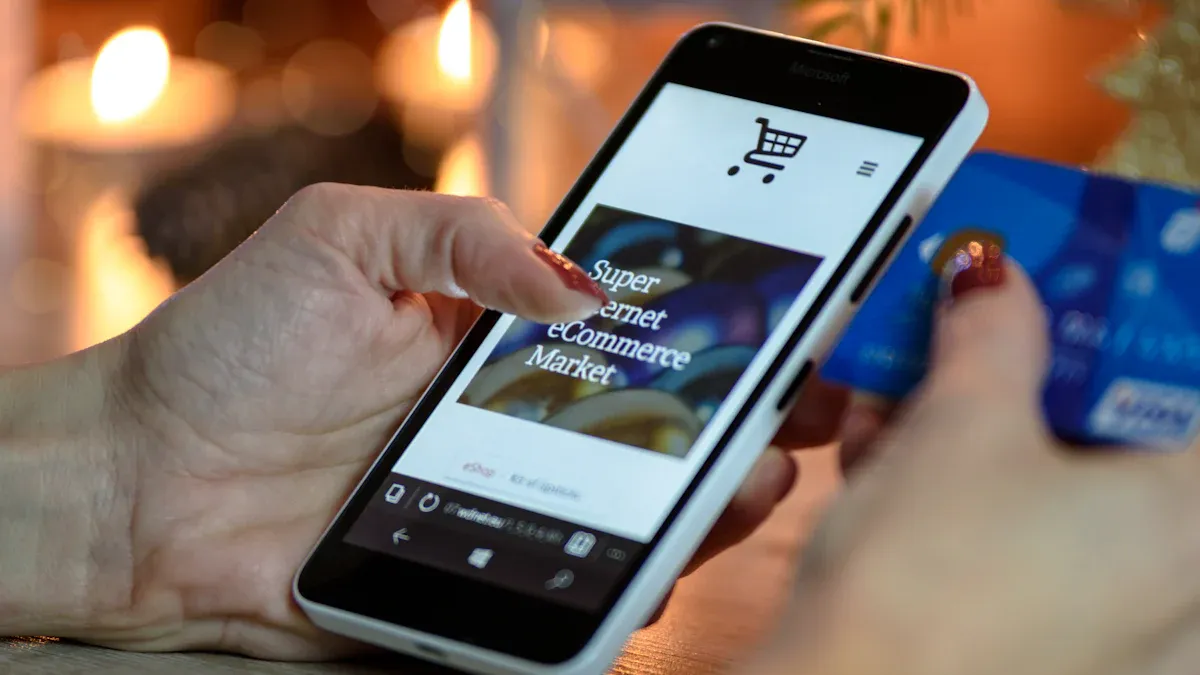
Optimize Website Speed and Mobile Experience
Your website’s speed and mobile experience can make or break your ecommerce success. A slow-loading site frustrates users and drives them away. Research shows that websites loading in one second have three times higher conversions than those taking five seconds. Plus, every second shaved off your load time can boost your conversion rate by 17%. That’s a huge opportunity to win over more customers.
Mobile optimization is equally critical. With more people shopping on their phones, your site must look and work great on smaller screens. Ensure buttons are easy to tap, text is readable, and images load quickly. Tools like Google’s PageSpeed Insights can help you identify areas for improvement.
Tip: Compress images, use a content delivery network (CDN), and minimize JavaScript to speed up your site. These small tweaks can significantly enhance user trust and engagement.
Simplify Navigation and Enhance Product Pages
Imagine walking into a store where everything is scattered. You’d leave, right? The same applies to your ecommerce site. Simplified navigation helps users find what they need quickly. Use clear categories, a search bar, and intuitive menus. For example, Techsmith used heatmaps to discover users preferred clicking on category images rather than product names. By redesigning their pages, they created a smoother experience and reduced frustration.
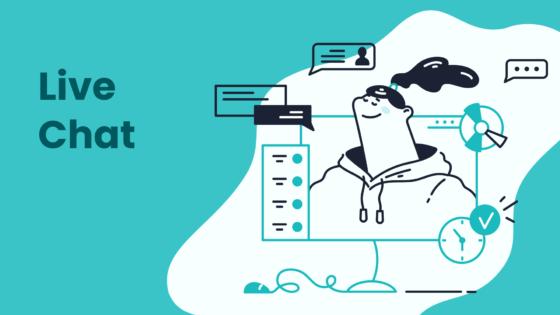
Your product pages also play a big role in conversions. High-quality images, detailed descriptions, and customer reviews can make a difference. Highlight key features and benefits to show why your product is worth buying. Adding personalization, like recommending related items, can further boost engagement. Sobot’s Live Chat can assist here by answering questions instantly, helping visitors make confident decisions.
Pro Tip: Use dynamic content like videos or 360-degree views to make your product pages more interactive and engaging.
Streamline the Checkout Process
A short checkout process is essential for reducing cart abandonment. Each extra step in the checkout journey increases the chances of losing a sale. Simplify it by removing unnecessary fields and offering guest checkout options. One-click checkout solutions are a game-changer, providing a fast and hassle-free experience that encourages repeat purchases.
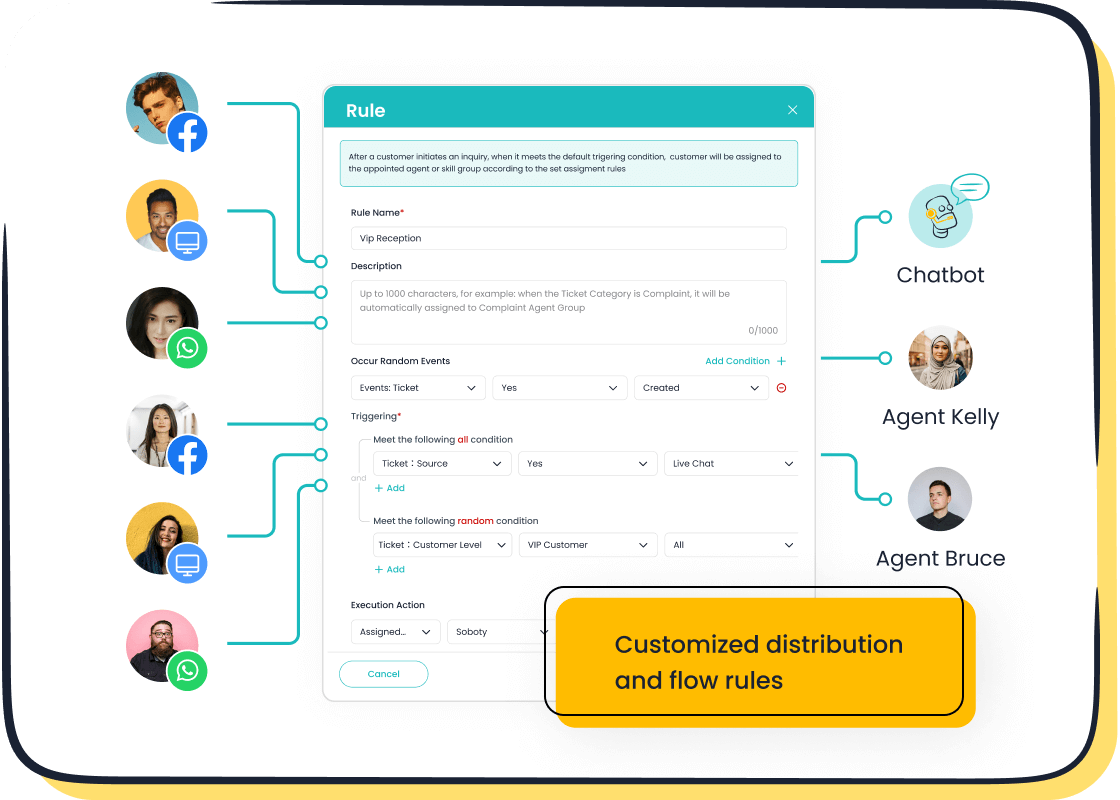
Security and transparency are also key. Display trust badges and clearly outline shipping costs upfront. This builds confidence and reduces anxiety about online transactions. Sobot’s Live Chat can further enhance the experience by addressing last-minute concerns in real time, ensuring customers complete their purchases.
Did You Know? A streamlined checkout process not only improves customer satisfaction but also fosters loyalty, leading to repeat business.
Leverage Trust Signals and Customer Reviews
Trust signals and customer reviews are like the secret sauce for boosting your ecommerce success. They reassure visitors that your store is reliable, your products are worth buying, and their money is safe. When people feel confident about your brand, they’re more likely to hit that “Buy Now” button.
Why Trust Signals Matter
Think about it—would you buy from a store with no reviews or proof of credibility? Probably not. Trust signals act as a safety net for your customers. They show that others have had positive experiences with your brand. For example, Cruyff added a Trustpilot widget to their checkout page and saw a 32% increase in conversions. Customers even added 12% more items to their carts because they felt more confident. Similarly, Scrum.org boosted their conversion rate by 27% after displaying Trustpilot reviews on their site. These numbers prove that trust signals aren’t just nice-to-have; they’re essential for ecommerce growth.
Types of Trust Signals
Here’s a quick look at the most effective trust signals you can use:
| Trust Signal Type | Description |
|---|---|
| Case studies | Real-world success stories that inspire trust. |
| Testimonials | Feedback from happy customers. |
| Social proof statistics | Data showing satisfied customer numbers. |
| Industry association logos | Logos that signify credibility. |
| Client/customer logos | Well-known client logos to build trust. |
| Publications logos | Mentions in reputable publications. |
| Employee certifications | Credentials that enhance trustworthiness. |
| Five-star ratings | High ratings from review sites. |
| Real-time notifications | Live updates showing customer activity. |
| Financial trust badges | Symbols indicating secure transactions. |
| Social media proof | Evidence of engagement on social platforms. |
| Partnership logos | Co-branding that boosts credibility. |
Adding these elements to your site can make a huge difference. For instance, 63% of EU consumers said a good Trustpilot score makes them more likely to buy from a brand. That’s a big deal when you’re trying to convert visitors into paying customers.
How to Use Customer Reviews Effectively
Customer reviews are like word-of-mouth recommendations in the digital world. They help potential buyers see your products through the eyes of real users. Highlighting reviews on your product pages or checkout process can increase conversions. For example, displaying five-star ratings or testimonials builds confidence. You can even use tools like Sobot’s Live Chat to collect feedback and showcase it on your site. This creates a loop of trust and engagement.
Tip: Don’t just focus on positive reviews. Addressing negative feedback publicly shows transparency and builds credibility.
Sobot’s Role in Building Trust
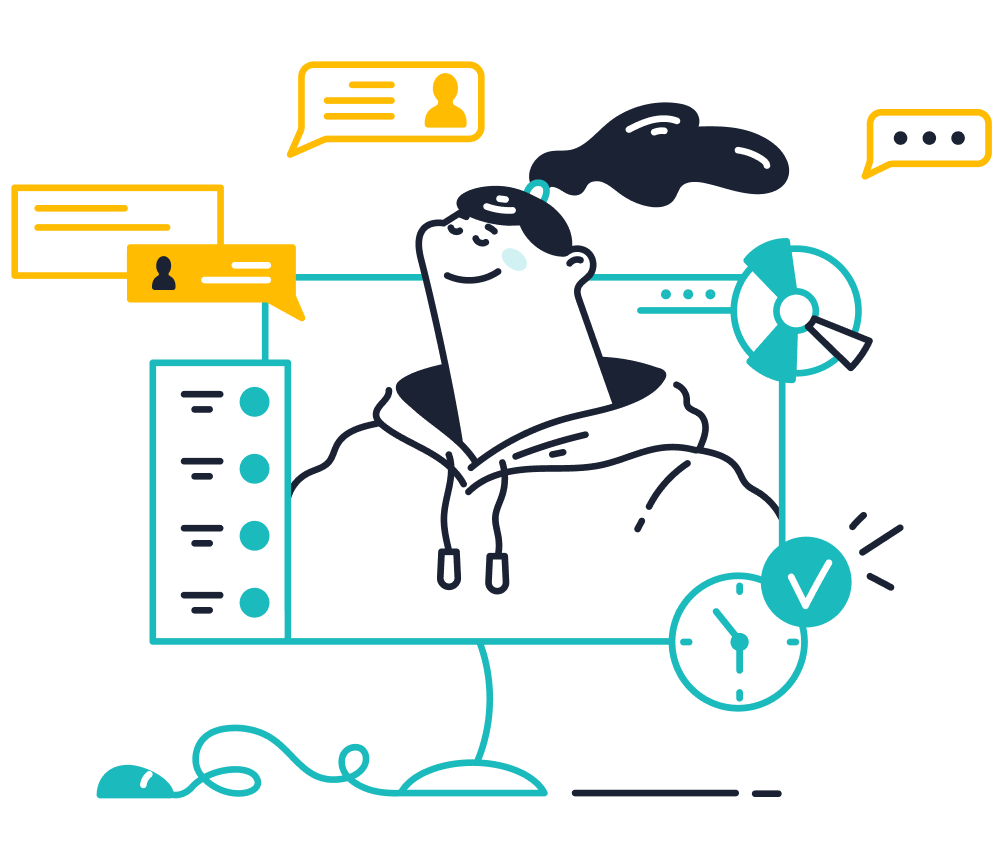
Sobot’s Live Chat can play a key role in leveraging trust signals. It allows you to engage with customers in real time, answer their questions, and resolve concerns instantly. By integrating customer reviews and satisfaction surveys into your chat system, you can showcase your commitment to quality service. Plus, Sobot’s analytics tools help you track customer sentiment, making it easier to highlight positive feedback and improve areas that need attention.
Trust signals and customer reviews aren’t just about making your site look good. They’re about building relationships with your customers. When people trust your brand, they’re more likely to buy—and keep coming back for more.
Key Strategies for Conversion Rate Optimization

A/B Testing for Data-Driven Insights
A/B testing is like running experiments to find out what works best for your ecommerce site. You test two versions of a webpage or element—like a headline or call-to-action button—and see which one gets better results. This strategy helps you make data-driven decisions that improve user experience and drive sales. For example, an ecommerce platform tested its checkout process and reduced distractions. The result? A 15% increase in conversion rates.
Shopify’s A/B testing tools let you segment your audience based on demographics and behavior. This means you can tailor your optimizations to specific groups, leading to higher conversion rates. Whether it’s testing different CTAs or tweaking your product descriptions, every small change can make a big impact.
Tip: Start with simple tests, like changing the color of your “Buy Now” button or rephrasing your headlines. These tweaks can reveal what resonates with your audience and lead to sustained revenue growth.
Personalization and Targeted Offers
Personalized recommendations are a game-changer for ecommerce. When you show customers products or offers tailored to their preferences, they’re more likely to buy. B2B brands that personalize their web experiences see an average conversion rate increase of 80%. Personalized emails deliver six times higher transaction rates, and targeted offers can boost annual revenue by 7%.
Here’s how personalization works: You analyze customer data to understand their behavior and preferences. Then, you use that information to create targeted offers. For instance, recommending accessories that complement a customer’s recent purchase can increase average sales by 20%.
| Metric | Value |
|---|---|
| Transaction Value Increase | 67% |
| Conversion Rate Increase | 300% |
| Annual Revenue Increase | 7% |
| Average Sales Increase | 20% |
| Higher Conversion Rates (CTAs) | 42% |

Pro Tip: Use tools like Sobot’s Live Chat to offer personalized recommendations in real time. This creates a user-friendly website experience that builds trust and drives high conversion rates.
Upselling and Cross-Selling Techniques
Upselling and cross-selling are powerful strategies for boosting profits. Upselling encourages customers to buy a higher-end product, while cross-selling suggests complementary items. These techniques can increase customer lifetime value by 20-40% and contribute up to 30% of ecommerce revenues.
For example, recommending a premium version of a product during checkout or bundling related items can lead to a 42% revenue increase. Brands using cross-selling tactics report a 20% profit boost and a 75% improvement in customer retention.
| Statistic Description | Percentage/Value |
|---|---|
| Increase in customer lifetime value due to upselling | 20-40% |
| Contribution of cross-selling to eCommerce revenues | 10-30% |
| Profit increase for brands using cross-selling | 20% |
| Boost in customer retention from upselling | 75% |
| Revenue increase from upselling and cross-selling | 42% |
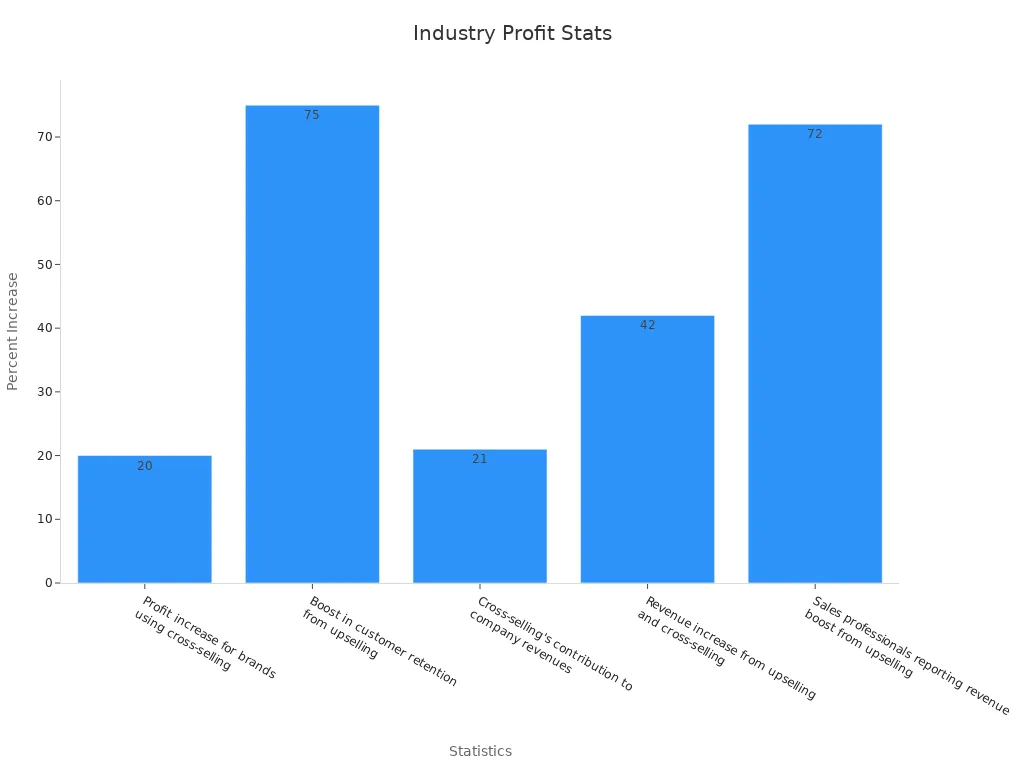
Tip: Use upselling and cross-selling techniques during checkout to maximize profits. Sobot’s Live Chat can help by suggesting personalized bundles or upgrades, making the process seamless for your customers.
Using Tools like Sobot Live Chat for Customer Engagement

Engaging your customers in real time can transform your ecommerce business. Sobot Live Chat is a powerful tool that helps you connect with visitors instantly, making them feel valued and understood. Whether they’re browsing your product pages or stuck during checkout, live chat provides the support they need to complete their purchase confidently.
Why Sobot Live Chat Works
Sobot Live Chat isn’t just about answering questions. It’s about creating meaningful interactions that drive results. For example, businesses using Sobot have seen measurable improvements in customer engagement:
| Metric | Impact on Customer Engagement |
|---|---|
| Customer Retention | Boosted by up to 30% |
| Conversion Rates | Increased by up to 20% |
| Customer Recommendations | 67% more likely to recommend |
| Loyalty Program Effectiveness | Increased retention by 25% |
These numbers show how live chat can turn casual visitors into loyal customers. Imagine a shopper hesitating over a product. With Sobot Live Chat, you can step in, answer their questions, and guide them toward a purchase—all in real time.
Features That Make a Difference
Sobot Live Chat offers features designed to enhance customer engagement. Its omnichannel support lets you interact with customers across websites, apps, and social media platforms like WhatsApp and Instagram. The AI-assisted tools help your agents respond faster, while built-in analytics provide insights into customer behavior. These features don’t just improve service—they boost your ecommerce conversion rates.
Tip: Use Sobot Live Chat to recommend products based on customer preferences. Personalized suggestions can increase sales and build trust.
Real-World Impact
Take a look at the measurable outcomes businesses have achieved with Sobot Live Chat:
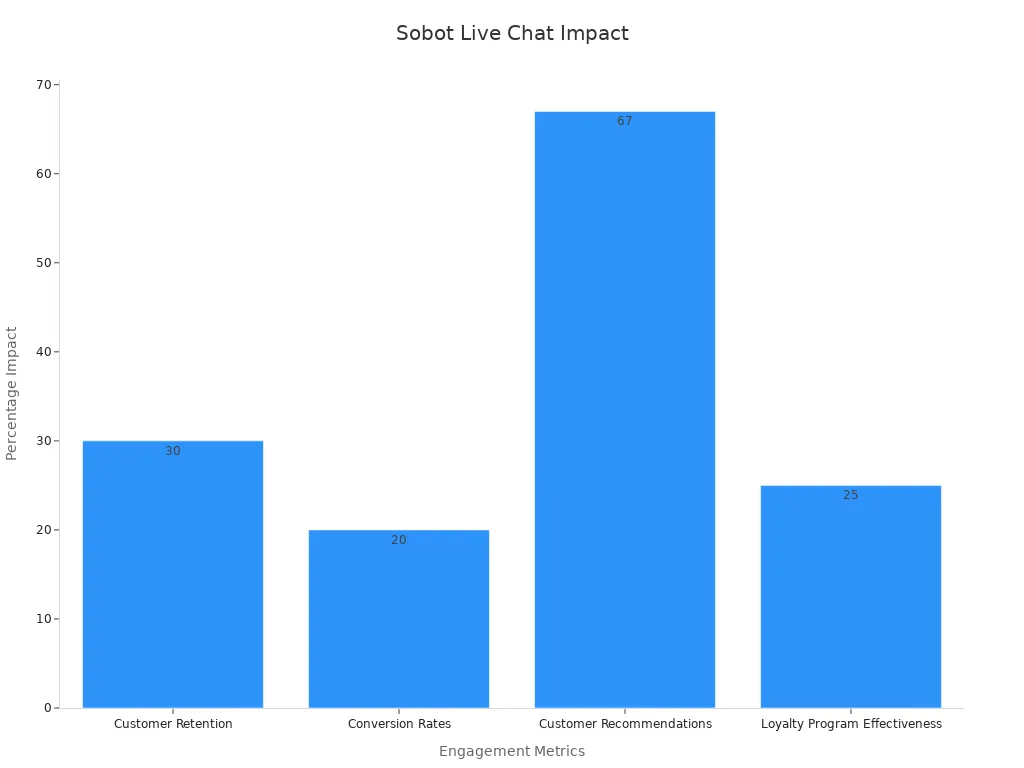
These results highlight the importance of real-time engagement. By using tools like Sobot Live Chat, you can create a seamless shopping experience that keeps customers coming back.
Sobot Live Chat isn’t just a tool—it’s a strategy for building relationships. When you engage your customers effectively, you don’t just increase sales. You create loyal advocates for your brand.
Avoiding Common Mistakes in Ecommerce Conversion Rate Optimization
Neglecting Mobile Optimization
If your ecommerce site isn’t mobile-friendly, you’re losing a huge chunk of potential customers. Mobile shopping is booming, with millions of users browsing and buying on their phones daily. Yet, 73.1% of web designers agree that poor mobile responsiveness is one of the top reasons visitors leave a site. A non-responsive design not only frustrates users but also pushes them straight to your competitors.
Mobile optimization is more than just resizing your website for smaller screens. It’s about creating a seamless experience. Buttons should be easy to tap, text should be readable, and navigation should feel intuitive. Google research shows that 72% of consumers expect mobile-friendly sites. If your site doesn’t meet these expectations, you risk losing 74% of visitors who shop exclusively on mobile devices.
Tip: Test your site on different devices. Tools like Google’s Mobile-Friendly Test can help you identify and fix issues quickly.
Overcomplicating the User Journey
A complicated user journey is like a maze—confusing and frustrating. When visitors struggle to find what they need, they’re more likely to abandon their carts. Studies show that complex designs and poorly optimized checkout processes are major barriers to conversions.
Keep things simple. Use clear navigation menus, visible call-to-action buttons, and a clean layout. A straightforward design helps users focus on what matters—your products. For example, a simple checkout process with fewer steps can significantly reduce cart abandonment rates. Remember, the easier it is for customers to shop, the more likely they are to complete their purchase.
Pro Tip: Map out your user journey. Identify any roadblocks and remove unnecessary steps to create a smoother experience.
Ignoring Page Load Speed
Page load speed is a silent killer of conversions. Every extra second your site takes to load increases the chances of visitors leaving. A study by Portent revealed that ecommerce sites loading in one second have conversion rates three times higher than those taking five seconds.
Slow load times don’t just hurt conversions—they damage your brand’s reputation. Visitors expect fast, seamless experiences. If your site lags, they’ll leave and may never return. Vodafone’s A/B testing showed that improving their page load speed by 31% led to an 8% increase in sales.
Quick Fix: Compress images, use caching, and minimize code to speed up your site. Faster pages mean happier customers and higher sales.
Failing to Analyze Customer Behavior
Ignoring customer behavior is like flying blind in the world of ecommerce. If you don’t know what your visitors are doing—or why they’re leaving—you’re missing out on valuable opportunities to improve. Understanding how customers interact with your site helps you identify pain points and make changes that drive conversions.
Let’s look at the numbers. Did you know that 65% of users abandon their carts? That’s a huge chunk of potential sales slipping through the cracks. Behavioral analysis can uncover why this happens. Maybe your checkout process is too complicated, or your shipping costs aren’t clear. By addressing these issues, you can turn abandoned carts into completed purchases.
Here’s a quick breakdown of how customer behavior impacts conversion rates:
| Statistic | Implication |
|---|---|
| 65% of users abandon their carts | Indicates a significant barrier to conversion that can be addressed through behavioral analysis. |
| eCommerce conversion rates average just 3% | Highlights the low success rate in converting visitors, emphasizing the need for analysis. |
| 68% of shoppers expect tailored experiences | Suggests that personalization can enhance conversion rates, which requires understanding customer behavior. |
| 91% are more likely to shop with brands providing personalized recommendations | Reinforces the importance of analyzing behavior to meet customer expectations and improve conversions. |
| 26% cite complicated checkout processes as a reason for cart abandonment | Identifies a specific area where analysis can lead to improvements in the conversion process. |
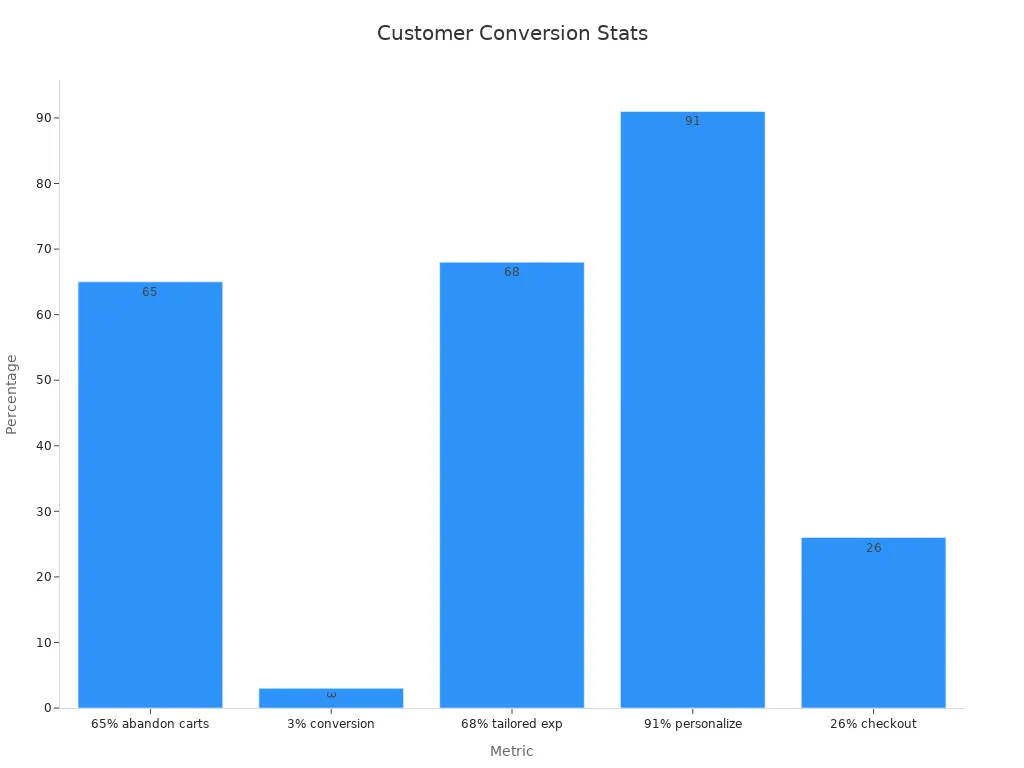
When you analyze customer behavior, you can also create personalized experiences. For example, 91% of shoppers say they’re more likely to buy from brands that offer tailored recommendations. This means tracking what your visitors browse, click, and buy can help you suggest products they’ll love. Tools like Sobot Live Chat can even assist by gathering real-time insights and engaging customers directly.
Failing to analyze behavior doesn’t just hurt your sales—it damages trust. Customers expect you to understand their needs. When you deliver a seamless, personalized experience, they’re more likely to stick around and shop again.
Expert Tips for Implementing Effective Practices
Leveraging Analytics Tools for Continuous Improvement
Analytics tools are your secret weapon for boosting ecommerce success. They help you track what’s working and what’s not, so you can make smarter decisions. Tools like Google Analytics and HubSpot are great for monitoring key performance indicators (KPIs) like bounce rates, cart abandonment, and conversion rates. By reviewing this data regularly, you can spot trends and adjust your strategies. For example, quarterly reviews let you see which CTAs are driving clicks and which ones need tweaking.
A/B testing is another game-changer. It allows you to test different versions of your website or ads to see what resonates with your audience. Imagine testing two CTAs—one says “Shop Now,” and the other says “Grab Your Deal.” The results can tell you which one gets more clicks, helping you create more compelling CTAs in the future. Remember, continuous testing and optimization keep you ahead of changing consumer behaviors.
Tip: Use analytics to personalize your site. When you know what your customers like, you can offer tailored recommendations that boost conversions.
Incorporating Limited-Time Promotions and Discounts
Limited-time promotions create urgency, encouraging customers to act fast. Think about Black Friday or Cyber Monday sales. These events often lead to a 15-25% increase in redemption rates. Even smaller campaigns, like 24-hour flash sales, can triple your conversion rates compared to open-ended offers. Adding a countdown timer to your CTAs can make them even more compelling.
Here’s a quick look at how different promotions perform:
| Promotion Type | Redemption Rate (%) |
|---|---|
| Black Friday/Cyber Monday | 15-25% |
| Back-to-school (August/Sept) | 30-35% |
| Time-limited offers (24-48h) | 3x higher than open-ended |
Mobile shoppers love these deals too. Over 70% of digital coupons are redeemed on smartphones, and first-time customers are especially likely to take advantage of discounts. So, if you’re not running time-sensitive campaigns, you’re leaving money on the table.
Pro Tip: Pair your promotions with compelling CTAs like “Claim Your Discount Now” to drive even more conversions.
Providing Multiple Payment Options
Offering multiple payment options makes shopping easier for your customers. Some prefer credit cards, while others might use digital wallets like PayPal or Apple Pay. In countries like Kenya, mobile payment systems like M-Pesa have revolutionized ecommerce by making it accessible to unbanked populations. When you cater to different preferences, you remove barriers to purchase.
Here’s what studies show about payment preferences:
| Study | Findings |
|---|---|
| Cruijsen, Hernandez & Jonker (2015) | 65% cash usage at retail outlets; preference for electronic payments in ecommerce. |
| Jonker et al. (2017) | Shift from cash to debit cards; higher cash usage at street vendors. |
Adding options like buy-now-pay-later services can also boost conversions. These methods appeal to budget-conscious shoppers, making it easier for them to commit to a purchase. The more flexible you are, the more likely customers are to complete their transactions.
Tip: Highlight your payment options near your CTAs to reassure customers they can pay their way.
Using Sobot Live Chat to Enhance Customer Support
Customer support can make or break your ecommerce business. When customers feel heard and valued, they’re more likely to trust your brand and return for future purchases. Sobot Live Chat offers a powerful way to elevate your customer support by providing instant, personalized assistance that keeps shoppers engaged.
Faster Responses, Happier Customers
Speed matters in customer support. Nobody likes waiting for answers, especially during busy shopping seasons. Sobot Live Chat helps you respond faster than ever. For example, Glamnetic reduced their First Response Time from 8 minutes to just 40 seconds during Black Friday and Cyber Monday sales. That’s a game-changer when every second counts.
Here’s how response times compare:
| Metric | Good Performance | Better Performance | AI-enabled Performance |
|---|---|---|---|
| First Response Time (Live Chat) | 1 minute or less | 40 seconds or less | As low as 40 seconds (Glamnetic during BFCM 2024) |
Most companies struggle with response times. In fact, 62% of businesses don’t reply to customer emails at all. Sobot Live Chat ensures your ecommerce store doesn’t fall into that category. By offering real-time support, you can address customer concerns instantly, reducing frustration and boosting satisfaction.
Personalized Support That Builds Trust
Sobot Live Chat isn’t just fast—it’s smart. Its AI-powered tools analyze customer behavior and provide tailored responses. Imagine a shopper browsing your site and hesitating over a product. With Sobot Live Chat, you can step in, answer their questions, and even recommend complementary items. This personalized approach builds trust and encourages purchases.
Seamless Integration Across Channels
Your customers don’t just shop on your website. They’re on social media, apps, and messaging platforms. Sobot Live Chat connects with all these channels, ensuring you never miss an opportunity to engage. Whether it’s WhatsApp, Instagram, or Telegram, you can provide consistent support wherever your customers are.
Tip: Use Sobot Live Chat to gather feedback after each interaction. Satisfaction surveys help you understand what’s working and where you can improve.
Sobot Live Chat transforms customer support into a competitive advantage. By responding quickly, offering personalized assistance, and engaging across multiple platforms, you create an ecommerce experience that keeps customers coming back.
Ecommerce conversion rate optimization is the key to turning visitors into loyal customers and driving long-term business growth. By focusing on metrics like sales conversion rates and cart abandonment rates, you can pinpoint areas to improve and create a smoother shopping experience. Strategies like simplifying navigation, leveraging trust signals, and using tools like Sobot Live Chat can make a measurable difference.
Start small. Test one or two tips, like streamlining your checkout process or adding customer reviews. You’ll see how even minor changes can boost your ecommerce success. Ready to take the next step? Explore tools and resources that can help you optimize further and grow your business.
FAQ
1. What is the ideal conversion rate for an ecommerce store?
The ideal conversion rate depends on your industry. For most ecommerce stores, a rate between 2% and 5% is considered good. If your store hits 4.7%, you’re in the top 10%. Use benchmarks to set realistic goals for your business.
2. How can Sobot Live Chat improve my conversion rate?
Sobot Live Chat engages visitors instantly, answers their questions, and provides personalized recommendations. This real-time interaction builds trust and confidence, turning hesitant shoppers into buyers. Businesses using Sobot have seen up to a 38% increase in conversions.
3. Why do customers abandon their carts?
Common reasons include unexpected shipping costs, complicated checkout processes, and lack of payment options. Simplify your checkout, display costs upfront, and offer multiple payment methods to reduce cart abandonment.
4. How often should I run A/B tests on my site?
Run A/B tests regularly, especially when launching new features or campaigns. Testing every quarter helps you stay ahead of changing customer preferences and optimize your site for better conversions.
5. Can trust signals really boost sales?
Absolutely! Trust signals like customer reviews, ratings, and badges reassure visitors about your store’s reliability. Adding these elements can increase conversions by up to 32%, as proven by brands like Cruyff and Scrum.org.
See Also
Boost Your Sales With Ecommerce Live Chat Solutions
Increase Shopify Revenue Using Live Chat Features
Best Ecommerce Live Chat Tools To Use In 2024